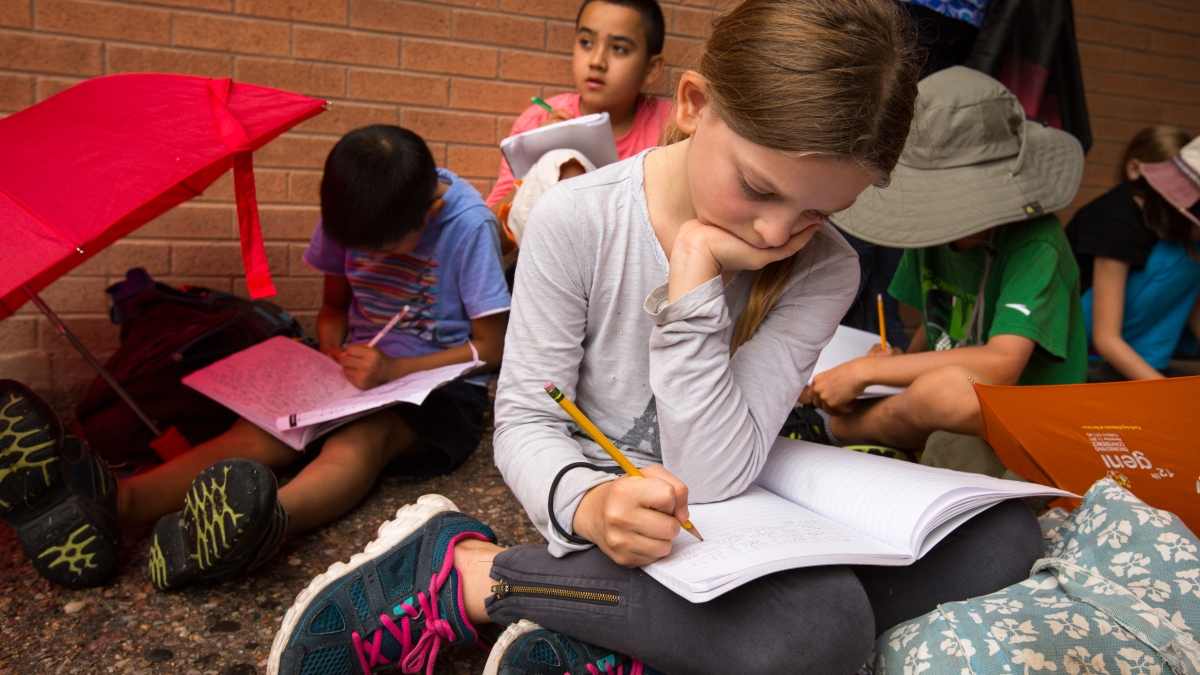ASU summer program allows youth to explore the craft of writing

Eight-year-old Tamsin Hurlbut, with others, writes her thoughts after walking over the University Bridge on ASU's Tempe campus.
Photo by: Charlie Leight
Tasmin Hurlbut felt like royalty.
That’s what the eight-year-old read after she wrote about standing atop University Bridge during a rare summer rain in Tempe.
Chances are she also felt like a writer.
The fourth grader was one of several children in rl txt – or “real text” – a two-week summer youth writing camp sponsored by the Central Arizona Writing Project within the Department of English at Arizona State University. The course aims to help students of varied ages feel more comfortable about their writing skills.
On Friday, June 5, rl txt students across ASU’s Polytechnic, Tempe and West campuses joined together in a “writing marathon.” Groups of students stopped at various monuments and points of interest and spent time writing there, allowing the physical spaces to inspire their words.
Before heading out on the tour, class instructors encouraged students to think about the question: “Where does writing hide?”
For Hurlbut, it was on that bridge.
“This is a very big bridge. It was raining when I crossed it,” she read aloud. “I felt like I was the emperor of the world.”
Encouraging students to feel like writers
The mission of rl txt isn’t just to get young people to track their prose. It’s also to instill the confidence of writing onto future generations of educators.
Dawn Lambson, clinical assistant professor of English at ASU, is just one of several instructional team members, who are writers themselves, overseeing a class of rl txt students.
“I’ve taught for 30 years, and the last 10 years with university students who are thinking of becoming teachers. I find very few of them who are comfortable teaching writing because they don’t see themselves as writers,” she said.
Lambson says she conducts an exercise at the start of each semester. She asks the students to raise their hands if they are “readers.” Nearly every one of them raises their hands. Then she asks the class how many of them are “writers.” Maybe one or two students will raise their hands. She says that’s indicative of how students think.
“We need to start instilling in kids and teaching them when they are young and creative that they’re writers,” Lambson says. “Once they get that into their heads, there’s no stopping them and it makes all the difference in the world. We need to start changing the idea of what a writer is.”
ASU's Central Arizona Writing Project is an affiliate of the National Writing Project, where teachers are trained in leadership and best practices in writing pedagogy.
“Each place we go to is an invitation to write,” Lambson said to the students before they departed. “Write about the space or how it inspires you.”
Caitlin Vasko, who will be entering eighth grade at Copperwood Elementary in Glendale this fall, had no trouble finding inspiration on the lawn outside West campus’ Fletcher Library.
The 13-year-old, who signed up for rl txt after her language arts teacher expressed enthusiasm for one of her short stories, wrote about the beauty of nature around her – the wind in the tree branches, the swaying blades of grass and how they contrasted with the solid, immovable brick buildings.
Both students and instructors responded to the writing with a polite “thank you.” No other comments were permitted in order to discourage students from thinking of one another’s writing as “good” or “bad,” and to teach them that there is no right or wrong way to express one’s self.
Rohan Nishtala, 14, who is about to start his freshman year at Basis Chandler, wore a brown T-shirt that read: “I’m Not Lazy, Just Energy Efficient.” He says he was inspired by Ray Bradbury’s 1954 short story, “All Summer in a Day,” when writing in the stairwell of Santan Hall at the Polytechnic campus. His writing had more of an apocalyptic, sci-fi take.
“I wanted to write about my own little world, and so I created it in my head,” Nishtala said.
Returning as writers
Upon returning to their classrooms for a de-briefing after the tour, instructors were first to share about their experiences with students.
Debra LaPlante, a librarian at SS. Simon & Jude Cathedral School in Phoenix, told her students how she “went to Paris in her mind” while she was writing around West campus.
Eight-year-old Azael Anchondo, replied, “I know how! Because when you’re writing about it, your mind’s in Paris.”
LaPlante smiled and nodded approvingly.
“I love to watch the kids grow in confidence as writers, to see them go from writing being a mandatory thing to them wanting to have a chance to grow in creativity.”
Marshall Terrill and Charlie Leight contributed to this story.